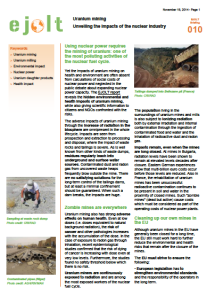
Using nuclear power requires the mining of uranium: one of the most polluting activities of the nuclear fuel cycle. Yet the impacts of uranium mining on health and environment are often absent from calculations of social costs of nuclear power and neglected in the public debate about expanding nuclear power capacity. The EJOLT report reveals the hidden environmental and health impacts of uranium mining, while also giving scientific information to citizens and NGOs confronted with the risks.
The adverse impacts of uranium mining through the increase of radiation in the biosphere are omnipresent in the whole lifecycle. Impacts are seen from prospection and extraction to processing and disposal, where the impact of waste rocks and tailings is severe. As is well known from other kinds of waste dumps, residues regularly leach into underground and surface water sources. Contaminated dust and radon gas from uncovered waste heaps frequently blow outside the mine. There are no satisfying solutions for the long-term control of the tailings dams, but at least a minimal confinement should be guaranteed. When such a dam breaks, the impacts are huge.
Zombie mines are everywhere
Uranium mining also has strong adverse effects on human health. Even at low doses (i.e. doses equivalent to natural background radiation), the risk of cancer and other pathologies increases with the accumulation of the dose. In the case of exposure to radon gas through inhalation, recent epidemiological studies confirmed that the risk of dying of cancer is increasing with dose even at very low levels. Furthermore, the studies found no safety threshold below which there is no risk. Uranium miners are continuously exposed to radiation and are among the most exposed workers of the nuclear fuel cycle.
Read more in the 2 page EJOLT briefing on uranium mining (.pdf)

The project ENVJUSTICE has received funding from the European Research Council (ERC) under the European Union’s Horizon 2020 research and innovation programme (grant agreement No. 695446)